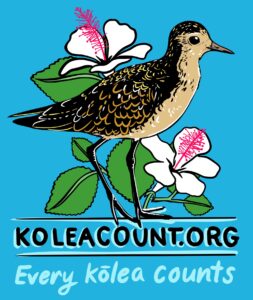
KoleaCount is an ongoing citizen science project of the Hawaiʻi Audubon Society . Graphic by Kate Righter, HAS Education, Outreach and Communications Manger
March 25, 2024
Part of springtime fun in Hawaii is watching our plovers’ changes color and size. It’s also the only time of year we know for sure that the bird we’ve been admiring in our yard, park, or playground is male or female.
Kōlea begin shedding their winter feathers, and growing their breeding-colored feathers, in February. This energy-intensive transformation is gradual, enabling the birds to continue to fly and forage fully feathered. By now, however, most plovers are close to their full wardrobe change. From now until the the end of April, when the birds leave for Alaska, we can finally tell the girls from the boys.
Because kōlea male colors are more dramatic, we notice those changes first. The male’s white racing stripe lining his all-black chest looks like a birdie tuxedo, tailored to perfection.
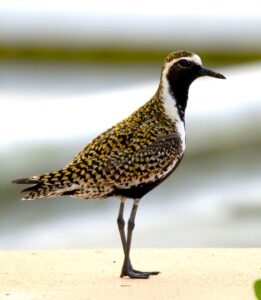
A Big Island male in full formal attire. ©Ann Tanimoto-Johnson
More subtle beauty is the female’s frock: Her creamy, dappled, over-the-shoulder shawl outlines a black-and-white speckled chest.
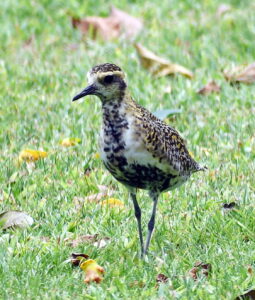
Female kōlea’s dappled chest feathers remind me of sequins on prom dresses. ©Susan Scott
As if the fronts of those outfits aren’t stunning enough, the back feathers of both sexes shout out the color of the bird’s English middle name: Pacific Golden-Plover.
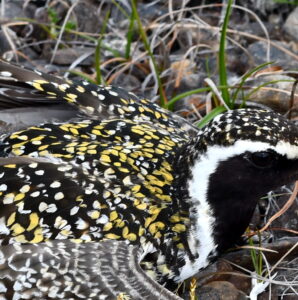
Golden back feathers of a male guarding his eggs. Nome, Alaska. ©Susan Scott
(For those wondering about my spelling: Among American bird professionals, it’s standard to capitalize all English bird names. In the Hawaiian language, however, bird names are not capitalized.)
But colors aren’t the only differences we’re seeing in our March kolea. They’re also getting fat.
Fat stores calories, and because the birds need extra energy to fly 3,000 miles in 3 days to their Alaska breeding grounds, our kōlea must bulk up in spring. That’s why, in addition to new feather colors, we’re also noticing changes in the birds’ body shapes.
In winter, the birds weigh about 4 ounces. By the end of April, they’re nearly double that, about 7 ounces. If the bird doesn’t get enough food to fatten up, it knows it cannot make the journey. When you see kōlea in June, those are the birds that stayed for the summer. Please report sightings in the REPORT tab of KoleaCount.
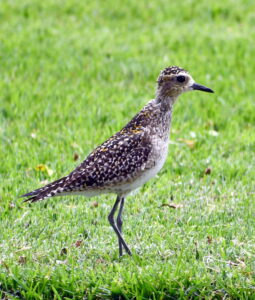
This thin bird did not molt or migrate. (April 21st photo.) It spent the summer in Punchbowl Cemetery. ©Susan Scott
For some kolea, gaining weight in spring means changing foraging methods. For instance, our bird, Jake, who lives in solitude all winter on the golf course fronting my house, starts visiting our lanai in February. That’s because Jake remembers that the couple who live there sometimes toss him bits of scrambled egg, a source of fat and protein he needs for his coming trip. (Tip: A stream from a squirt-gun discourages mynahs and doves from going for the egg, but doesn’t faze Jake.)
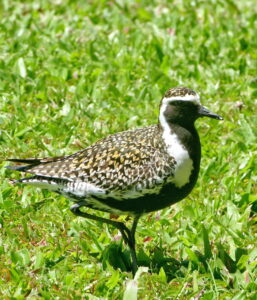
Our Jake posing in his tailored tux. ©Susan Scott
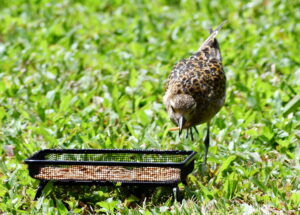
Live mealworms, available in pet stores, are another healthy food for friendly plovers. A resident in Pohai Nani, a retirement community in Kaneohe, raised mealworms for his kōlea, who came when the man called. ©Susan Scott
We’ve had this egg thing going with Jake for seven years now, a fact I know from photo dates. Feeding not only helps Jake get the extra nutrients he needs for his journey, it also boosts the spirits of his human friends: me, Craig, and several neighbors. In this world of so much bad news, we cherish these close encounters with a native bird.
March 31 is the last day of this season for counting kōlea in Hawaii’s parks, cemeteries, and golf courses, but please keep walking, watching, and wondering. We have another whole month to admire and appreciate our shapeshifting shorebirds.
P.S. In last week’s photo below, it looks as if a kōlea parent is leading its offspring through Waialua’s Puʻuiki Cemetery. Not so. The eight smaller birds behind the kōlea are ʻakekeke (ruddy turnstones), another shorebird species. The two sometimes forage together in Hawaiʻi. Here, kōlea offspring look the same as adults.
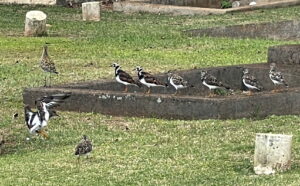
©Susan Scott